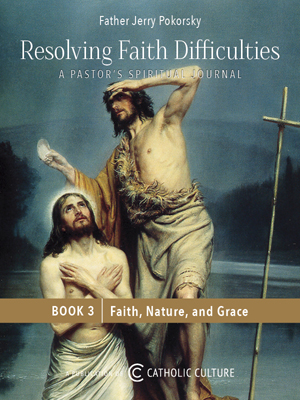On letting reality shine...through Christ
By Dr. Jeff Mirus ( bio - articles - email ) | Oct 29, 2024
The Church today—including every member of the Church—has to make a strong effort to go beyond what “everybody knows” to be true or good or popular. It may be a small thing, but it is not encouraging that the Holy See has adopted an anime-style mascot for the 2025 jubilee year and the 2025 world fair in Osaka, Japan, but at least the Holy See will go beyond that by putting Caravaggio’s Deposition and, perhaps less wisely, Chagall’s White Crucifixion on display as well.
Against this confused background, Phil Lawler’s commentary (What the NY Times missed in the latest encyclical: the whole point) reinforces an argument I made ten days ago in Truth and Goodness? Yes, but we must not forget Beauty. Since the world at large generally has no idea what we are talking about any longer, it is becoming increasingly important to use “the beautiful” to encourage in them a desire to go more deeply into truth and goodness.
Anime simply lowers the bar. It trivializes the holy and the numinous—not unlike Thomas Kinkade at Christmas and Easter, except perhaps worse. This is not the way to draw people beyond the abject shallowness so characteristic of the “reality” they believe they already know. The same thing can be said of many (but not all) of the emphases of the current pontificate, as if by stating the obvious about the things people already know (for example, the horrors which go unchecked through a lack of human fraternity) they will spontaneously turn to Christ without having any idea at all who Christ is.
My point is simply this: The lowest common denominator only works as a first step to a more sublime goal. In 1923, the Methodist Charles C. Selecman tried to make this fundamental point when he entitled his book about human culture “Christ or Chaos”, and he did not exaggerate. For that is the choice, and it has always been the choice.
Raising the Bar
Pope Francis’ latest encyclical on the Sacred Heart is certainly one way of raising the bar. But if everything else in the Church’s workaday world is presented in terms of mere human services, a genuine fraternity will never catch on. The concept of universal human fraternity was definitively and securely established only when Christ Himself was born. It depends on a common Father who loves His children and will sacrifice anything to get them to accept, benefit from, and return that love. Recognizing others as brothers and sisters is only possible if we all have the same Father. Just as important, loving each other as brothers and sisters is only possible if we acknowledge and love our Father in return.
God sent His Divine Son to suffer and die in order to reconcile us as true brothers and sisters in love for Him. My point is that anything else is fiddling while Rome burns. Or, in terms of art, anything else is mere kitsch.
Now note the meaning of this word kitsch: “Art, objects, or design considered to be in poor taste because of excessive garishness or sentimentality” (Oxford). Or again: “Something that appeals to popular or lowbrow taste and is often of poor quality; a tacky or lowbrow quality or condition” (Webster). Anime is the very essence of kitsch. I even have some doubts about Mark Chagal. Picasso said of him: “I don’t know where he gets those images…. He must have an angel in his head.” But Chagall himself said of Picasso: “What a genius, that Picasso…. It’s a pity he doesn’t paint.” Art can be confusing; it requires some degree of tolerance. But every observer really should wonder whether there is any “there” there.
I may be expressing a prejudice, but there is a far deeper truth to be found. As Christianity has waned, we in the West have frequently attempted to reduce all the arts, including music, to the lowest common denominator, along with every other appeal to the human mind and human sensibilities. But just as beauty cannot be reduced to the lowest common denominator, neither can goodness and truth. It is never enough to seek common ground, except perhaps to emphasize what we are all missing, for the most important thing we all have in common is that we are all sinners.
Focusing on the Real
As just one example, it is true that the White Crucifixion captures something of our modern chaos, and that may well be a good thing. But it is also true that the Vatican’s anime mascot captures nothing, while Caravaggio’s Deposition, as Christ is taken down from the Cross, begins at last to open us to all that Is.
Or all Who Is. We Catholics ought to know that “Who Is” is the One who said “I Am”. We ought to open ourselves to Him, and we ought never to obscure His light. Of course, as sinners, we will all obscure it at times, but surely we must strive to make this inadvertent. To choose to obscure it in the name of outreach is at the least a serious error, and to do so deliberately is a mortal sin.
The Light of the world has already died and risen. The veneer of “the cute” is often a coward’s way of obscuring the light by denigrating mature conviction. My point is that while the Light may occasionally be dimly reflected in the Cute, it shines only through the Real.
All comments are moderated. To lighten our editing burden, only current donors are allowed to Sound Off. If you are a current donor, log in to see the comment form; otherwise please support our work, and Sound Off!








